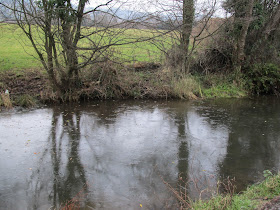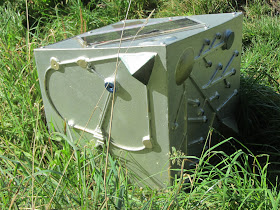Shrouded in cloud and fog, Gelligaer Common insisted on hiding its secrets and much of its mystery this week.
After walking across an exposed, waterlogged landscape, we were asked to imagine ancient tribes erecting the Cefn Stone at the entrance to their settlement. With no food or healthy drinking water or even building materials in sight, it is difficult to believe.
Standing on the bleak mountainside alone, it remains the only marker of this possibly bronze age homestead. The stone now rests at an angle of almost 45 deg. due, we are told, to failed attempts by historians in the 18th or 19th century to excavate its secrets.
Out of the mist, a lone off-road cyclist scurries past, watched by sheep and horses who gaze with little interest. Soon the object of their gaze will become the subject of a 'Helicopter Heroes,' episode, unless he is very well aquainted with his route across this pockmarked landscape.

A little way away, the cloud still masks the mountain, but Capel Gwladys slowly appears. A standing stone carved with celtic basket weave (probably about 30 years old,) marks the spot of a church established Circa 430AD.

As our walking group approaches up the slope, we could have been following the path of worshippers from two thousand years earlier. Although in these weather conditions, this appears a relatively isolated, peaceful spot, for a Christian Church to have been built here would have required quite a large and dedicated congregation.
Is it here she died?
Is it here she lies,
Gwladys.
Shrouded in mist,
buried in time,
this Celtic Princess.
Tales retold
memories reborn.
A million faces
shine through the mist
trying to see history,
to see Gwladys.
 |
| Bank of Roman Stockade |
 |
| Remaining bank from Roman Stockade |
David, our Leader, explained how Roman Soldiers were expected to march out of camp and build a stockade to spend the night before returning.
Originally a formidable structure, surrounded by an earth bank within a ditch, dug four feet deep, and topped with wooden stakes it would have been patrolled by Roman guards. The remains of the stockade, gently sloping grassy mounds, are pointed out to the unwary observer, and lie invisible from the roadway.
Amid much talk of ghosts, I wonder how would those soldiers have felt, digging these trenches after marching all day, each carrying a full pack including wooden stakes.
Its difficult for us to imagine these men working and camping here and achieving so much. But did they ever think their work would be inspected in the twentieth century?

These soldiers in thonged leather sandals, tunics and hand-tooled metal helmets would never have believed that people wearing man-made fibres, and waterproof Gore-Tex Boots would be recording the remains of their work using digital cameras, phones and Ipads and then clambering into a purple diesel-engined coach.
My first visit to Gelligaer Common, despite the fog and low cloud, has been truly inspirational.



















































